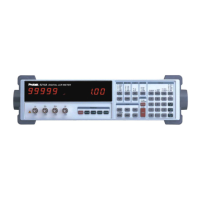8
Accuracy and Calibration
How to Assess and Control the Accuracy
The accuracy achieved by the 9216A Digital LCR Meter depends on several factors. In
this chapter, equations are given for estimating the accuracy of a specific measurement,
and procedures are given for calibrating the meter.
Accuracy Specifications
Note: The accuracy of the 9216A that is stated in this chapter is valid for the following
conditions: (a) a warm-up time of at least 30 minutes, (b) a temperature of 23C 5C, (c)
the use of the built-in fixture, and (d) the completion of the open and short circuit calibra-
tions. In addition, the component being measured must have the following characteristic:
D < 0.1 for a capacitor, Q < 0.1 for a resistor, or Q > 10 for an inductor.
General Accuracy Equation
The accuracy of a measurement is a function of the ―basic impedance accuracy‖ at the
specific frequency, measurement rate, signal amplitude, and the impedance of the device
under test (DUT) relative to the measurement range. The basic instrument accuracy can
be determined from graphs given below. Additional factors affecting the accuracy are re-
lated to the measurement conditions and the impedance of the DUT. From these, the
accuracy of a particular measurement in its optimal range is calculated. See below for
the effects on measurements made out of an optimal range.
The basic equation for impedance accuracy equation is given by
Accuracy in % [A K
i
K
v
+ 100 (K
h
K
l
)], where (1)
A the basic impedance accuracy from Figure 2-1, which should be multiplied by two
if the unit is in constant voltage mode. Figure 2-1 is based on the fact that the
best accuracy occurs when the impedance to be measured is greater than ¼ the
source resistance and less than 4 times that resistance, and when the test fre-
quency is 1 kHz or less.
K
i
integration time factor, as given in Table 2-1.
K
v
drive voltage error factor, as given in Table 2-2. Note from Table 2-2 that K
v
is
defined as equal to 1.0 for the primary drive voltages (1.0, 0.5, and 0.25 Vrms).
K
h
, K
l
extreme range error terms, as given in Table 2-3. Note from Table 2-3 that K
l
is negligible for impedances above 100 and K
h
is negligible for impedances be-
low 1 k, both at all frequencies.

